A Reflexive Report on Dynamic Leadership
VerifiedAdded on 2023/06/05
|15
|3774
|183
AI Summary
This report explores and reflects on self-development as a leader to develop self-awareness. It presents an analysis and development of leadership potential and capabilities.
Contribute Materials
Your contribution can guide someone’s learning journey. Share your
documents today.
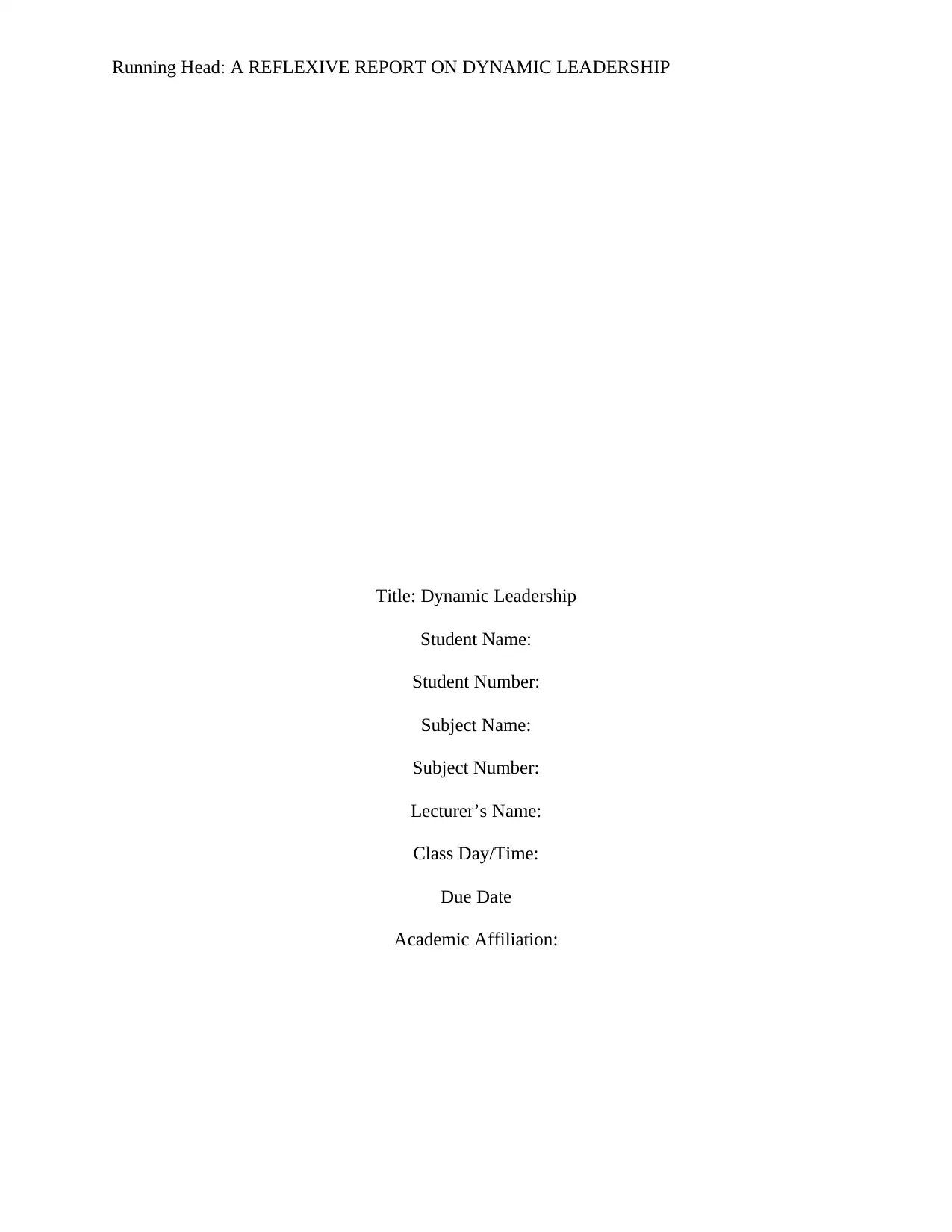
Running Head: A REFLEXIVE REPORT ON DYNAMIC LEADERSHIP
Title: Dynamic Leadership
Student Name:
Student Number:
Subject Name:
Subject Number:
Lecturer’s Name:
Class Day/Time:
Due Date
Academic Affiliation:
Title: Dynamic Leadership
Student Name:
Student Number:
Subject Name:
Subject Number:
Lecturer’s Name:
Class Day/Time:
Due Date
Academic Affiliation:
Secure Best Marks with AI Grader
Need help grading? Try our AI Grader for instant feedback on your assignments.
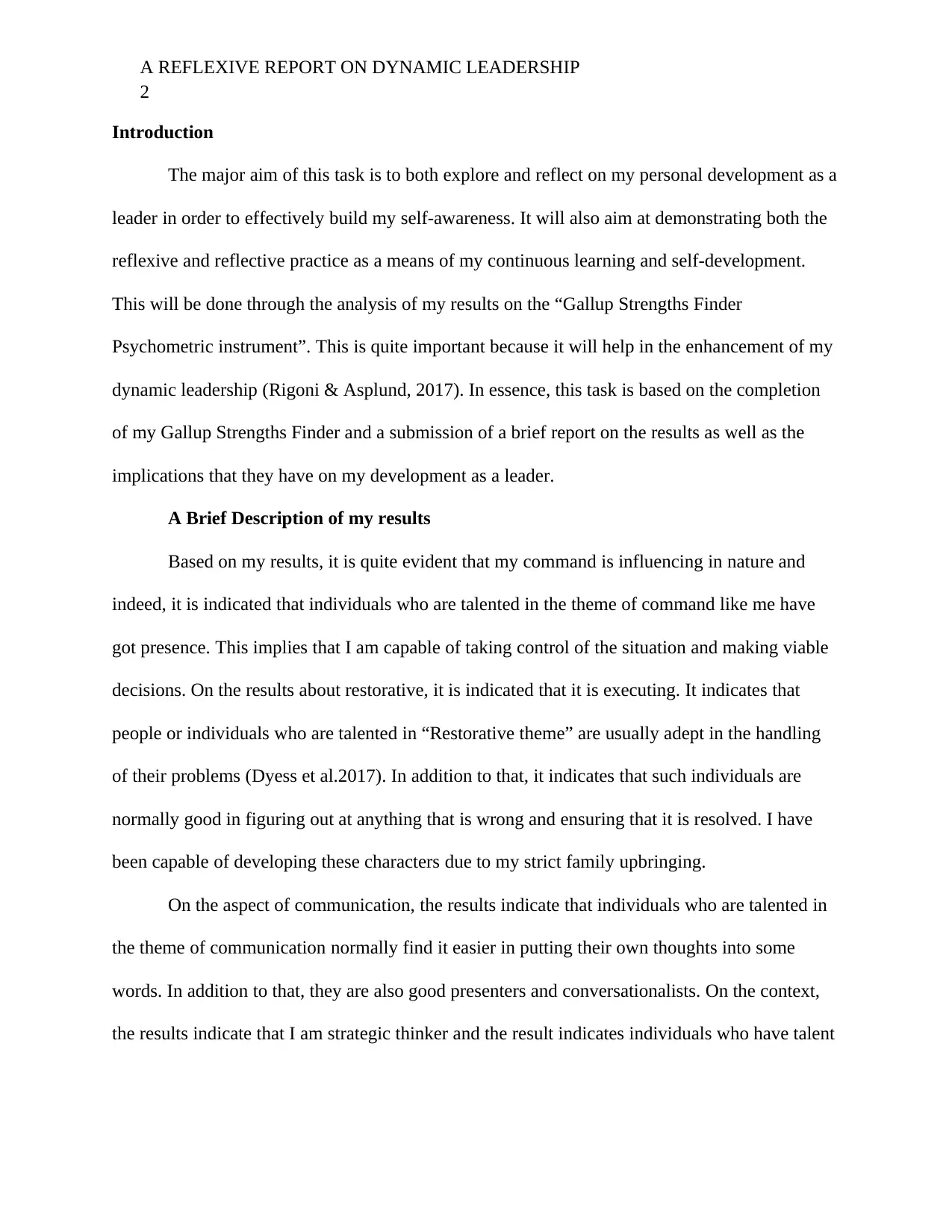
A REFLEXIVE REPORT ON DYNAMIC LEADERSHIP
2
Introduction
The major aim of this task is to both explore and reflect on my personal development as a
leader in order to effectively build my self-awareness. It will also aim at demonstrating both the
reflexive and reflective practice as a means of my continuous learning and self-development.
This will be done through the analysis of my results on the “Gallup Strengths Finder
Psychometric instrument”. This is quite important because it will help in the enhancement of my
dynamic leadership (Rigoni & Asplund, 2017). In essence, this task is based on the completion
of my Gallup Strengths Finder and a submission of a brief report on the results as well as the
implications that they have on my development as a leader.
A Brief Description of my results
Based on my results, it is quite evident that my command is influencing in nature and
indeed, it is indicated that individuals who are talented in the theme of command like me have
got presence. This implies that I am capable of taking control of the situation and making viable
decisions. On the results about restorative, it is indicated that it is executing. It indicates that
people or individuals who are talented in “Restorative theme” are usually adept in the handling
of their problems (Dyess et al.2017). In addition to that, it indicates that such individuals are
normally good in figuring out at anything that is wrong and ensuring that it is resolved. I have
been capable of developing these characters due to my strict family upbringing.
On the aspect of communication, the results indicate that individuals who are talented in
the theme of communication normally find it easier in putting their own thoughts into some
words. In addition to that, they are also good presenters and conversationalists. On the context,
the results indicate that I am strategic thinker and the result indicates individuals who have talent
2
Introduction
The major aim of this task is to both explore and reflect on my personal development as a
leader in order to effectively build my self-awareness. It will also aim at demonstrating both the
reflexive and reflective practice as a means of my continuous learning and self-development.
This will be done through the analysis of my results on the “Gallup Strengths Finder
Psychometric instrument”. This is quite important because it will help in the enhancement of my
dynamic leadership (Rigoni & Asplund, 2017). In essence, this task is based on the completion
of my Gallup Strengths Finder and a submission of a brief report on the results as well as the
implications that they have on my development as a leader.
A Brief Description of my results
Based on my results, it is quite evident that my command is influencing in nature and
indeed, it is indicated that individuals who are talented in the theme of command like me have
got presence. This implies that I am capable of taking control of the situation and making viable
decisions. On the results about restorative, it is indicated that it is executing. It indicates that
people or individuals who are talented in “Restorative theme” are usually adept in the handling
of their problems (Dyess et al.2017). In addition to that, it indicates that such individuals are
normally good in figuring out at anything that is wrong and ensuring that it is resolved. I have
been capable of developing these characters due to my strict family upbringing.
On the aspect of communication, the results indicate that individuals who are talented in
the theme of communication normally find it easier in putting their own thoughts into some
words. In addition to that, they are also good presenters and conversationalists. On the context,
the results indicate that I am strategic thinker and the result indicates individuals who have talent
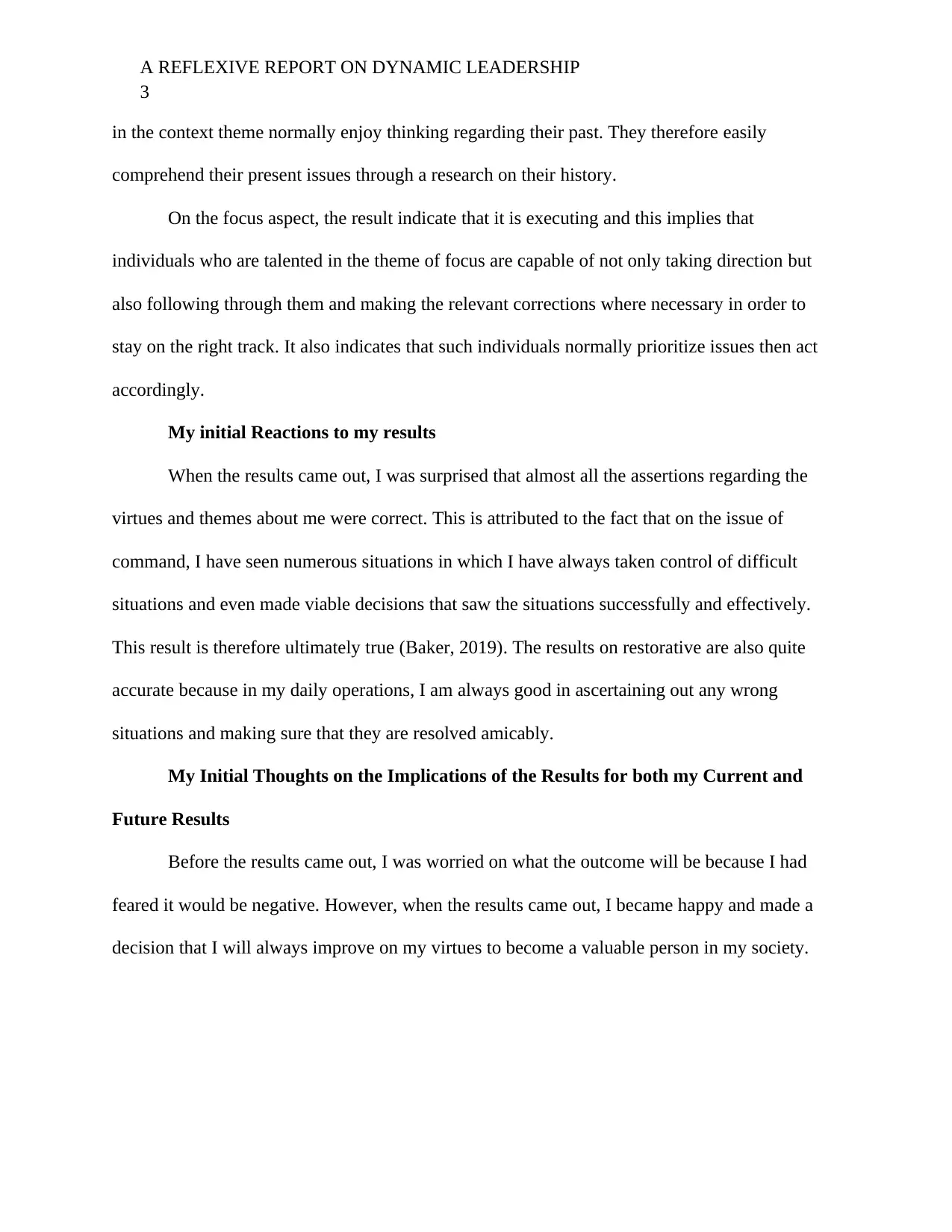
A REFLEXIVE REPORT ON DYNAMIC LEADERSHIP
3
in the context theme normally enjoy thinking regarding their past. They therefore easily
comprehend their present issues through a research on their history.
On the focus aspect, the result indicate that it is executing and this implies that
individuals who are talented in the theme of focus are capable of not only taking direction but
also following through them and making the relevant corrections where necessary in order to
stay on the right track. It also indicates that such individuals normally prioritize issues then act
accordingly.
My initial Reactions to my results
When the results came out, I was surprised that almost all the assertions regarding the
virtues and themes about me were correct. This is attributed to the fact that on the issue of
command, I have seen numerous situations in which I have always taken control of difficult
situations and even made viable decisions that saw the situations successfully and effectively.
This result is therefore ultimately true (Baker, 2019). The results on restorative are also quite
accurate because in my daily operations, I am always good in ascertaining out any wrong
situations and making sure that they are resolved amicably.
My Initial Thoughts on the Implications of the Results for both my Current and
Future Results
Before the results came out, I was worried on what the outcome will be because I had
feared it would be negative. However, when the results came out, I became happy and made a
decision that I will always improve on my virtues to become a valuable person in my society.
3
in the context theme normally enjoy thinking regarding their past. They therefore easily
comprehend their present issues through a research on their history.
On the focus aspect, the result indicate that it is executing and this implies that
individuals who are talented in the theme of focus are capable of not only taking direction but
also following through them and making the relevant corrections where necessary in order to
stay on the right track. It also indicates that such individuals normally prioritize issues then act
accordingly.
My initial Reactions to my results
When the results came out, I was surprised that almost all the assertions regarding the
virtues and themes about me were correct. This is attributed to the fact that on the issue of
command, I have seen numerous situations in which I have always taken control of difficult
situations and even made viable decisions that saw the situations successfully and effectively.
This result is therefore ultimately true (Baker, 2019). The results on restorative are also quite
accurate because in my daily operations, I am always good in ascertaining out any wrong
situations and making sure that they are resolved amicably.
My Initial Thoughts on the Implications of the Results for both my Current and
Future Results
Before the results came out, I was worried on what the outcome will be because I had
feared it would be negative. However, when the results came out, I became happy and made a
decision that I will always improve on my virtues to become a valuable person in my society.
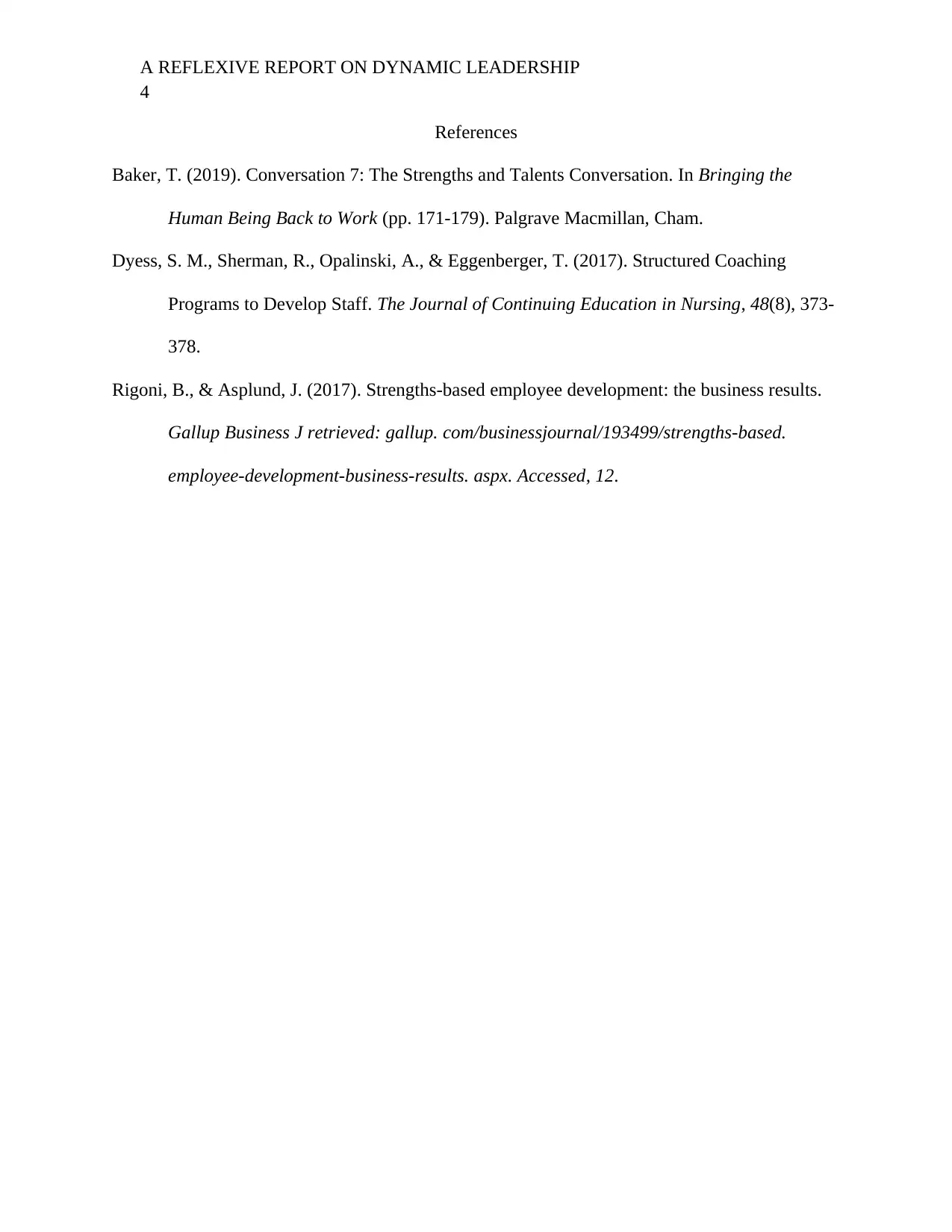
A REFLEXIVE REPORT ON DYNAMIC LEADERSHIP
4
References
Baker, T. (2019). Conversation 7: The Strengths and Talents Conversation. In Bringing the
Human Being Back to Work (pp. 171-179). Palgrave Macmillan, Cham.
Dyess, S. M., Sherman, R., Opalinski, A., & Eggenberger, T. (2017). Structured Coaching
Programs to Develop Staff. The Journal of Continuing Education in Nursing, 48(8), 373-
378.
Rigoni, B., & Asplund, J. (2017). Strengths-based employee development: the business results.
Gallup Business J retrieved: gallup. com/businessjournal/193499/strengths-based.
employee-development-business-results. aspx. Accessed, 12.
4
References
Baker, T. (2019). Conversation 7: The Strengths and Talents Conversation. In Bringing the
Human Being Back to Work (pp. 171-179). Palgrave Macmillan, Cham.
Dyess, S. M., Sherman, R., Opalinski, A., & Eggenberger, T. (2017). Structured Coaching
Programs to Develop Staff. The Journal of Continuing Education in Nursing, 48(8), 373-
378.
Rigoni, B., & Asplund, J. (2017). Strengths-based employee development: the business results.
Gallup Business J retrieved: gallup. com/businessjournal/193499/strengths-based.
employee-development-business-results. aspx. Accessed, 12.
Secure Best Marks with AI Grader
Need help grading? Try our AI Grader for instant feedback on your assignments.
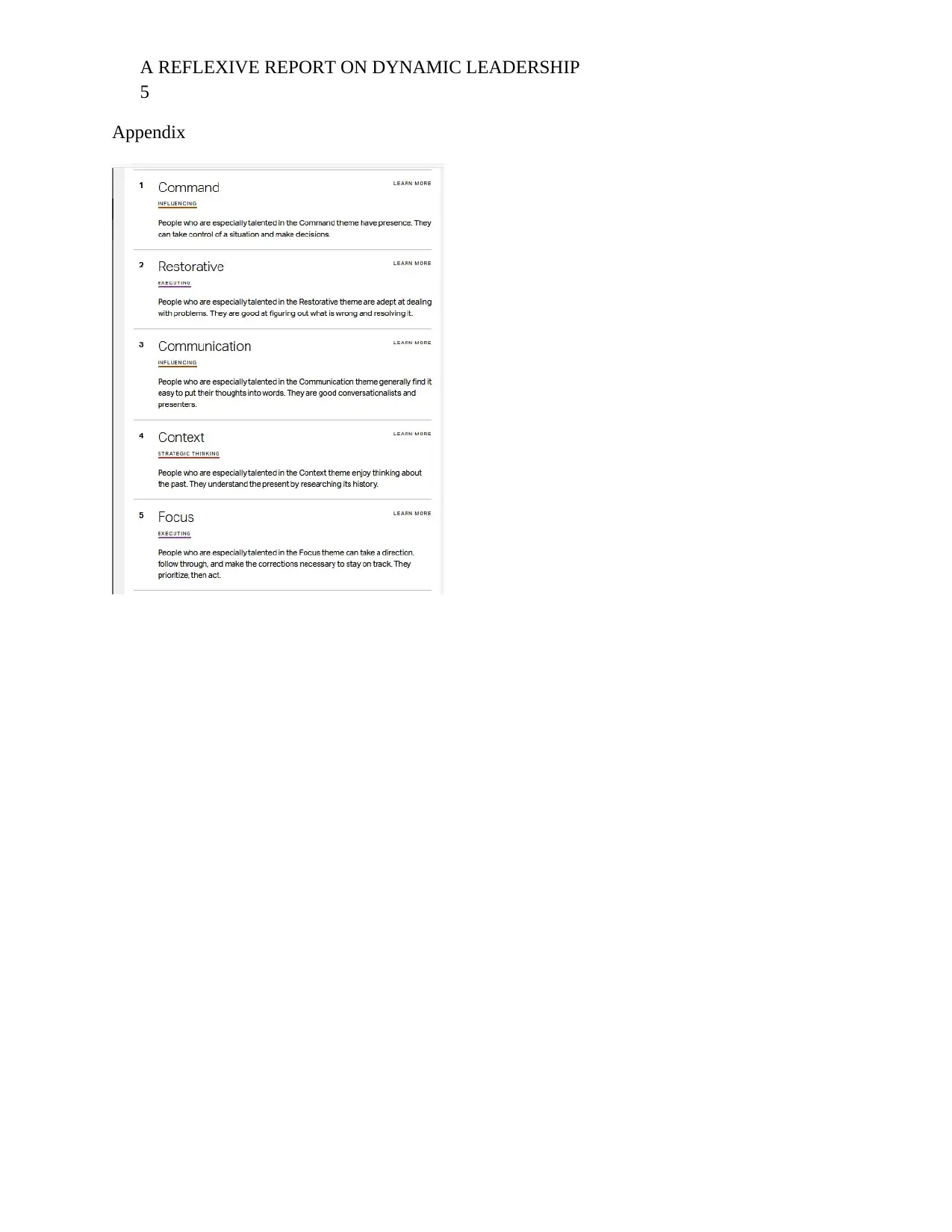
A REFLEXIVE REPORT ON DYNAMIC LEADERSHIP
5
Appendix
5
Appendix
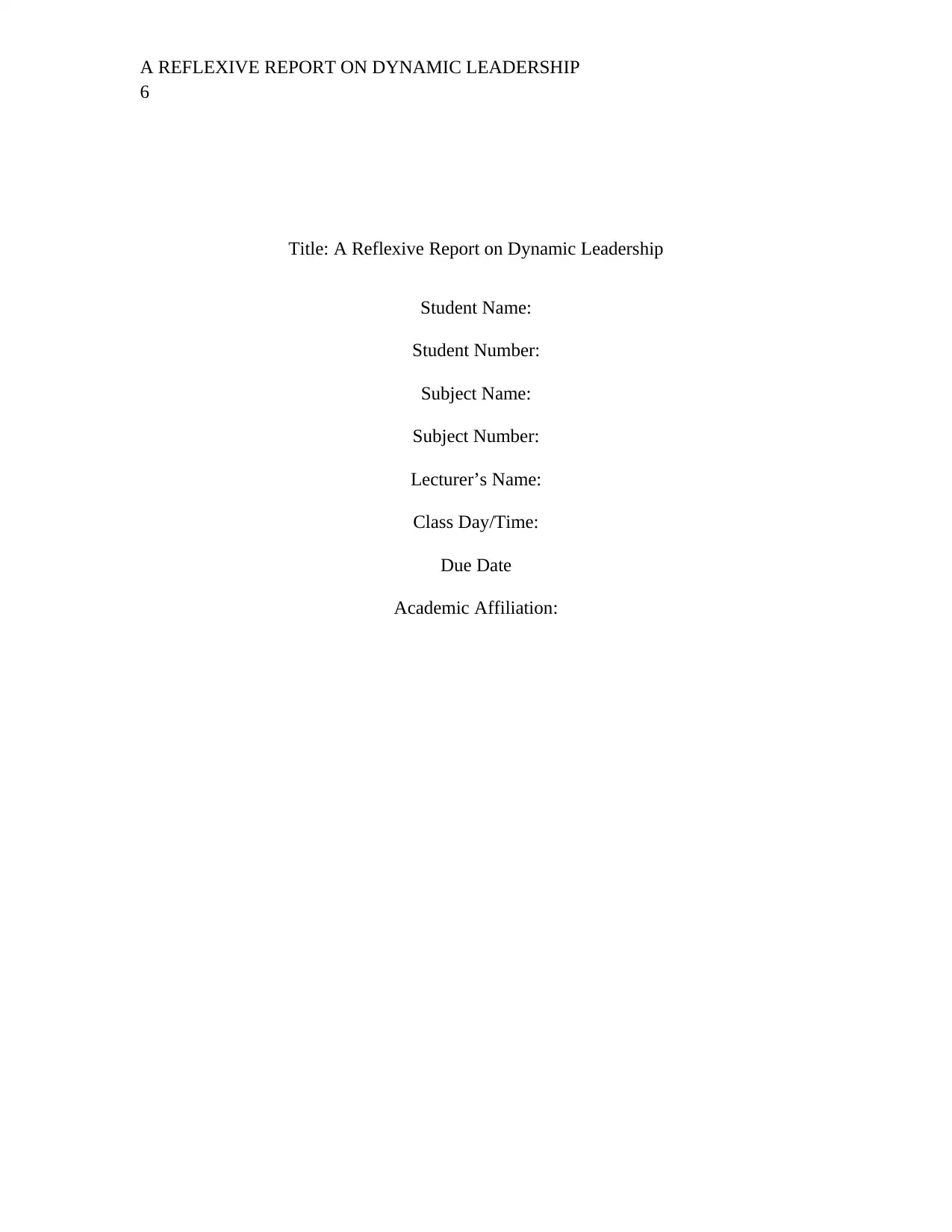
A REFLEXIVE REPORT ON DYNAMIC LEADERSHIP
6
Title: A Reflexive Report on Dynamic Leadership
Student Name:
Student Number:
Subject Name:
Subject Number:
Lecturer’s Name:
Class Day/Time:
Due Date
Academic Affiliation:
6
Title: A Reflexive Report on Dynamic Leadership
Student Name:
Student Number:
Subject Name:
Subject Number:
Lecturer’s Name:
Class Day/Time:
Due Date
Academic Affiliation:
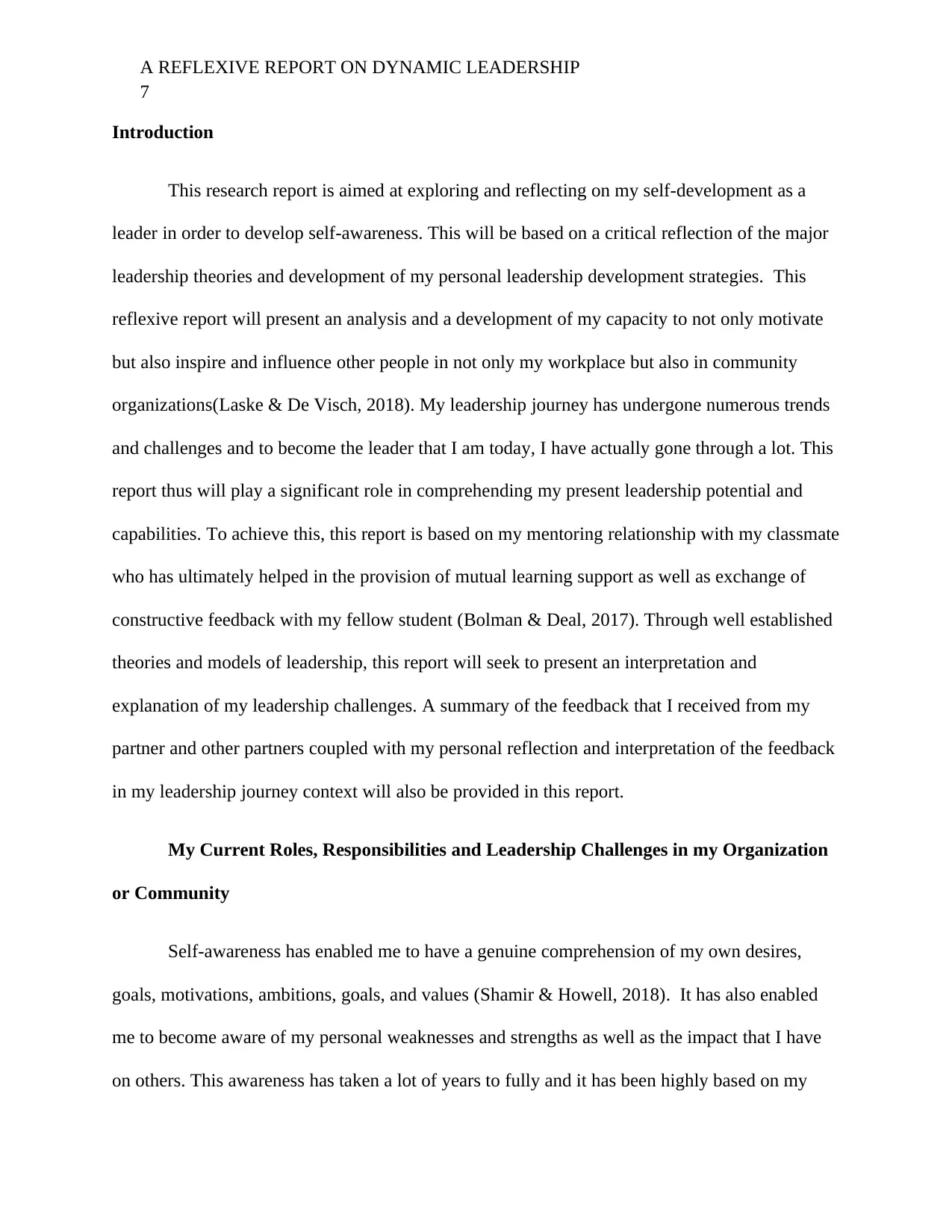
A REFLEXIVE REPORT ON DYNAMIC LEADERSHIP
7
Introduction
This research report is aimed at exploring and reflecting on my self-development as a
leader in order to develop self-awareness. This will be based on a critical reflection of the major
leadership theories and development of my personal leadership development strategies. This
reflexive report will present an analysis and a development of my capacity to not only motivate
but also inspire and influence other people in not only my workplace but also in community
organizations(Laske & De Visch, 2018). My leadership journey has undergone numerous trends
and challenges and to become the leader that I am today, I have actually gone through a lot. This
report thus will play a significant role in comprehending my present leadership potential and
capabilities. To achieve this, this report is based on my mentoring relationship with my classmate
who has ultimately helped in the provision of mutual learning support as well as exchange of
constructive feedback with my fellow student (Bolman & Deal, 2017). Through well established
theories and models of leadership, this report will seek to present an interpretation and
explanation of my leadership challenges. A summary of the feedback that I received from my
partner and other partners coupled with my personal reflection and interpretation of the feedback
in my leadership journey context will also be provided in this report.
My Current Roles, Responsibilities and Leadership Challenges in my Organization
or Community
Self-awareness has enabled me to have a genuine comprehension of my own desires,
goals, motivations, ambitions, goals, and values (Shamir & Howell, 2018). It has also enabled
me to become aware of my personal weaknesses and strengths as well as the impact that I have
on others. This awareness has taken a lot of years to fully and it has been highly based on my
7
Introduction
This research report is aimed at exploring and reflecting on my self-development as a
leader in order to develop self-awareness. This will be based on a critical reflection of the major
leadership theories and development of my personal leadership development strategies. This
reflexive report will present an analysis and a development of my capacity to not only motivate
but also inspire and influence other people in not only my workplace but also in community
organizations(Laske & De Visch, 2018). My leadership journey has undergone numerous trends
and challenges and to become the leader that I am today, I have actually gone through a lot. This
report thus will play a significant role in comprehending my present leadership potential and
capabilities. To achieve this, this report is based on my mentoring relationship with my classmate
who has ultimately helped in the provision of mutual learning support as well as exchange of
constructive feedback with my fellow student (Bolman & Deal, 2017). Through well established
theories and models of leadership, this report will seek to present an interpretation and
explanation of my leadership challenges. A summary of the feedback that I received from my
partner and other partners coupled with my personal reflection and interpretation of the feedback
in my leadership journey context will also be provided in this report.
My Current Roles, Responsibilities and Leadership Challenges in my Organization
or Community
Self-awareness has enabled me to have a genuine comprehension of my own desires,
goals, motivations, ambitions, goals, and values (Shamir & Howell, 2018). It has also enabled
me to become aware of my personal weaknesses and strengths as well as the impact that I have
on others. This awareness has taken a lot of years to fully and it has been highly based on my
Paraphrase This Document
Need a fresh take? Get an instant paraphrase of this document with our AI Paraphraser
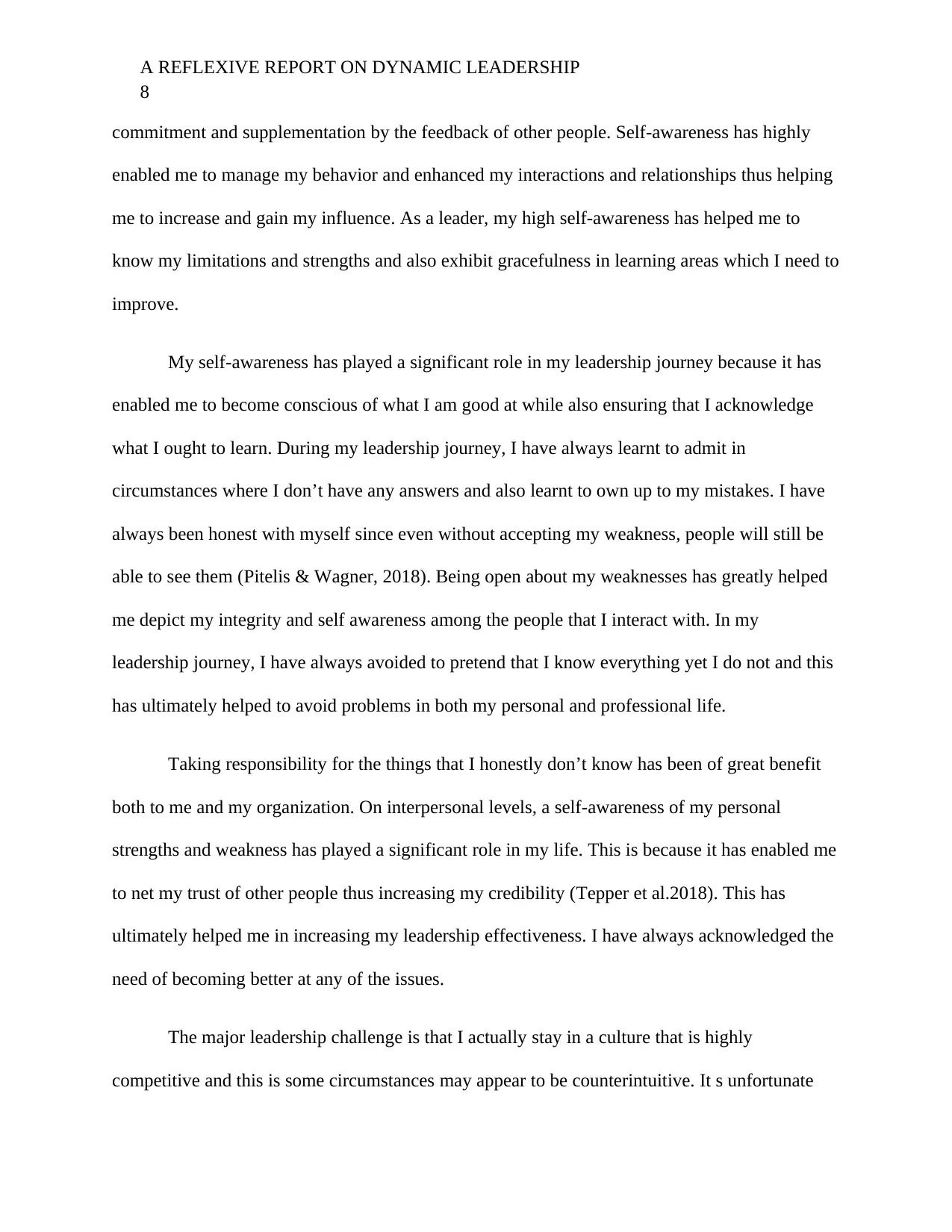
A REFLEXIVE REPORT ON DYNAMIC LEADERSHIP
8
commitment and supplementation by the feedback of other people. Self-awareness has highly
enabled me to manage my behavior and enhanced my interactions and relationships thus helping
me to increase and gain my influence. As a leader, my high self-awareness has helped me to
know my limitations and strengths and also exhibit gracefulness in learning areas which I need to
improve.
My self-awareness has played a significant role in my leadership journey because it has
enabled me to become conscious of what I am good at while also ensuring that I acknowledge
what I ought to learn. During my leadership journey, I have always learnt to admit in
circumstances where I don’t have any answers and also learnt to own up to my mistakes. I have
always been honest with myself since even without accepting my weakness, people will still be
able to see them (Pitelis & Wagner, 2018). Being open about my weaknesses has greatly helped
me depict my integrity and self awareness among the people that I interact with. In my
leadership journey, I have always avoided to pretend that I know everything yet I do not and this
has ultimately helped to avoid problems in both my personal and professional life.
Taking responsibility for the things that I honestly don’t know has been of great benefit
both to me and my organization. On interpersonal levels, a self-awareness of my personal
strengths and weakness has played a significant role in my life. This is because it has enabled me
to net my trust of other people thus increasing my credibility (Tepper et al.2018). This has
ultimately helped me in increasing my leadership effectiveness. I have always acknowledged the
need of becoming better at any of the issues.
The major leadership challenge is that I actually stay in a culture that is highly
competitive and this is some circumstances may appear to be counterintuitive. It s unfortunate
8
commitment and supplementation by the feedback of other people. Self-awareness has highly
enabled me to manage my behavior and enhanced my interactions and relationships thus helping
me to increase and gain my influence. As a leader, my high self-awareness has helped me to
know my limitations and strengths and also exhibit gracefulness in learning areas which I need to
improve.
My self-awareness has played a significant role in my leadership journey because it has
enabled me to become conscious of what I am good at while also ensuring that I acknowledge
what I ought to learn. During my leadership journey, I have always learnt to admit in
circumstances where I don’t have any answers and also learnt to own up to my mistakes. I have
always been honest with myself since even without accepting my weakness, people will still be
able to see them (Pitelis & Wagner, 2018). Being open about my weaknesses has greatly helped
me depict my integrity and self awareness among the people that I interact with. In my
leadership journey, I have always avoided to pretend that I know everything yet I do not and this
has ultimately helped to avoid problems in both my personal and professional life.
Taking responsibility for the things that I honestly don’t know has been of great benefit
both to me and my organization. On interpersonal levels, a self-awareness of my personal
strengths and weakness has played a significant role in my life. This is because it has enabled me
to net my trust of other people thus increasing my credibility (Tepper et al.2018). This has
ultimately helped me in increasing my leadership effectiveness. I have always acknowledged the
need of becoming better at any of the issues.
The major leadership challenge is that I actually stay in a culture that is highly
competitive and this is some circumstances may appear to be counterintuitive. It s unfortunate

A REFLEXIVE REPORT ON DYNAMIC LEADERSHIP
9
that my partner and other people operate on a strong belief that that they must always appear as
though they actually know everything every time or else other people will ultimately question
their own abilities thus diminishing their leadership effectiveness. Another significant challenge
that I have faced in my leadership journey is that I sometimes encounter behavioral clashes and
interpersonal clashes (Laske & De Visch, 2018).
The inability to differentiate style issues and personality issues also led to failure of my
realization of where the problem could be. These are quite different since while behavior is only
a matter of choice, personality is actually an “inherent” trait (Rosenbach, 2018). However, self-
examination helped me in making sure that the right behavior was embraced and I easily
recognized the poor habits. One significant challenge that I also experienced in my leadership
journey is that other individuals do not normally want to give us our feedback due to the fact that
they are fearful of retaliation and even fear that such feedback may ultimately ruin our
relationships.
My Key Aspects of my Leadership Journey
There are various aspects that have marked my leadership journey and these include
among others:
Self-examination
This has been a fastest route to my self-awareness and it has helped me to cope with
numerous problems in both my personal and professional life. As a leader, I have always realized
that I may not be a perfect entity just like organizations cannot be perfect entities (Lopez-
9
that my partner and other people operate on a strong belief that that they must always appear as
though they actually know everything every time or else other people will ultimately question
their own abilities thus diminishing their leadership effectiveness. Another significant challenge
that I have faced in my leadership journey is that I sometimes encounter behavioral clashes and
interpersonal clashes (Laske & De Visch, 2018).
The inability to differentiate style issues and personality issues also led to failure of my
realization of where the problem could be. These are quite different since while behavior is only
a matter of choice, personality is actually an “inherent” trait (Rosenbach, 2018). However, self-
examination helped me in making sure that the right behavior was embraced and I easily
recognized the poor habits. One significant challenge that I also experienced in my leadership
journey is that other individuals do not normally want to give us our feedback due to the fact that
they are fearful of retaliation and even fear that such feedback may ultimately ruin our
relationships.
My Key Aspects of my Leadership Journey
There are various aspects that have marked my leadership journey and these include
among others:
Self-examination
This has been a fastest route to my self-awareness and it has helped me to cope with
numerous problems in both my personal and professional life. As a leader, I have always realized
that I may not be a perfect entity just like organizations cannot be perfect entities (Lopez-
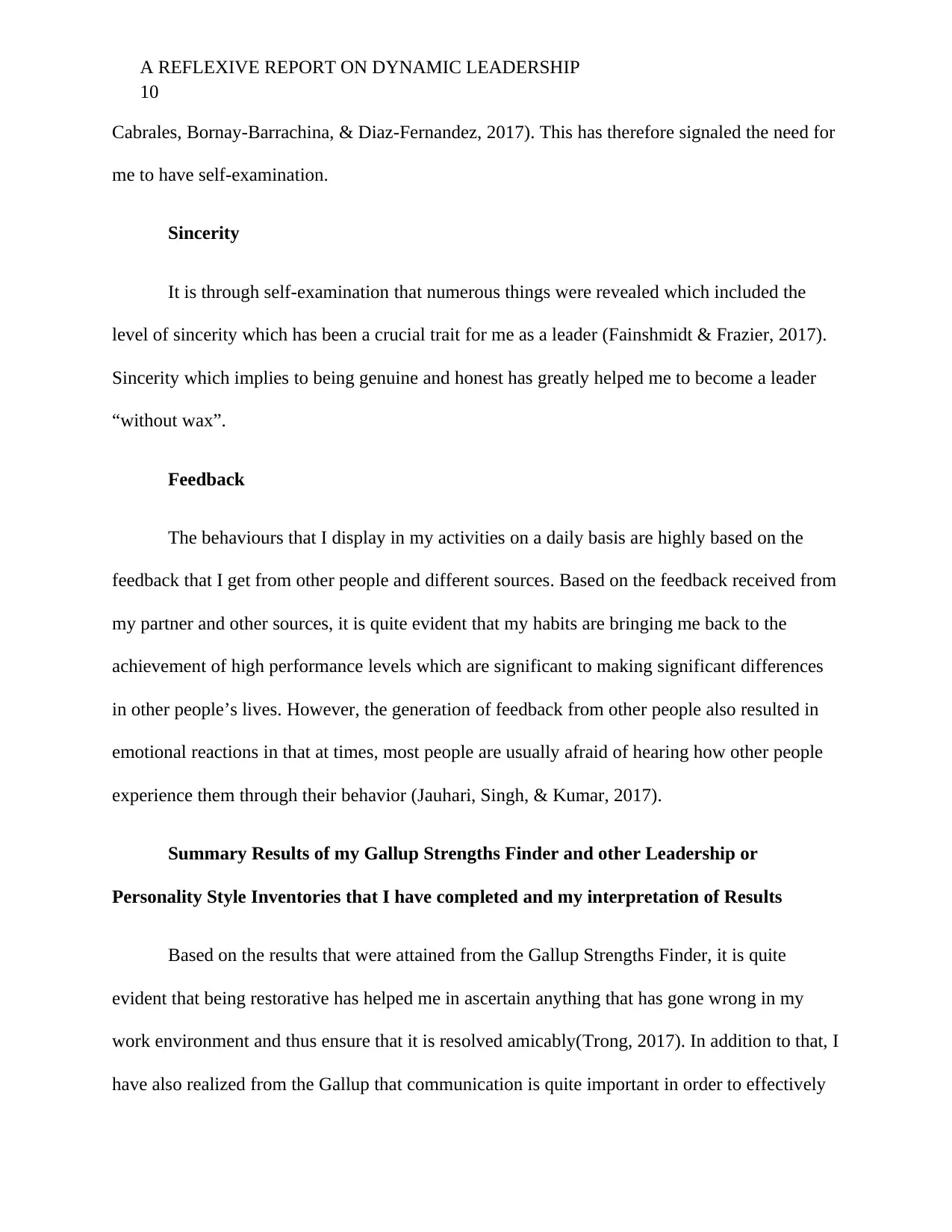
A REFLEXIVE REPORT ON DYNAMIC LEADERSHIP
10
Cabrales, Bornay-Barrachina, & Diaz-Fernandez, 2017). This has therefore signaled the need for
me to have self-examination.
Sincerity
It is through self-examination that numerous things were revealed which included the
level of sincerity which has been a crucial trait for me as a leader (Fainshmidt & Frazier, 2017).
Sincerity which implies to being genuine and honest has greatly helped me to become a leader
“without wax”.
Feedback
The behaviours that I display in my activities on a daily basis are highly based on the
feedback that I get from other people and different sources. Based on the feedback received from
my partner and other sources, it is quite evident that my habits are bringing me back to the
achievement of high performance levels which are significant to making significant differences
in other people’s lives. However, the generation of feedback from other people also resulted in
emotional reactions in that at times, most people are usually afraid of hearing how other people
experience them through their behavior (Jauhari, Singh, & Kumar, 2017).
Summary Results of my Gallup Strengths Finder and other Leadership or
Personality Style Inventories that I have completed and my interpretation of Results
Based on the results that were attained from the Gallup Strengths Finder, it is quite
evident that being restorative has helped me in ascertain anything that has gone wrong in my
work environment and thus ensure that it is resolved amicably(Trong, 2017). In addition to that, I
have also realized from the Gallup that communication is quite important in order to effectively
10
Cabrales, Bornay-Barrachina, & Diaz-Fernandez, 2017). This has therefore signaled the need for
me to have self-examination.
Sincerity
It is through self-examination that numerous things were revealed which included the
level of sincerity which has been a crucial trait for me as a leader (Fainshmidt & Frazier, 2017).
Sincerity which implies to being genuine and honest has greatly helped me to become a leader
“without wax”.
Feedback
The behaviours that I display in my activities on a daily basis are highly based on the
feedback that I get from other people and different sources. Based on the feedback received from
my partner and other sources, it is quite evident that my habits are bringing me back to the
achievement of high performance levels which are significant to making significant differences
in other people’s lives. However, the generation of feedback from other people also resulted in
emotional reactions in that at times, most people are usually afraid of hearing how other people
experience them through their behavior (Jauhari, Singh, & Kumar, 2017).
Summary Results of my Gallup Strengths Finder and other Leadership or
Personality Style Inventories that I have completed and my interpretation of Results
Based on the results that were attained from the Gallup Strengths Finder, it is quite
evident that being restorative has helped me in ascertain anything that has gone wrong in my
work environment and thus ensure that it is resolved amicably(Trong, 2017). In addition to that, I
have also realized from the Gallup that communication is quite important in order to effectively
Secure Best Marks with AI Grader
Need help grading? Try our AI Grader for instant feedback on your assignments.
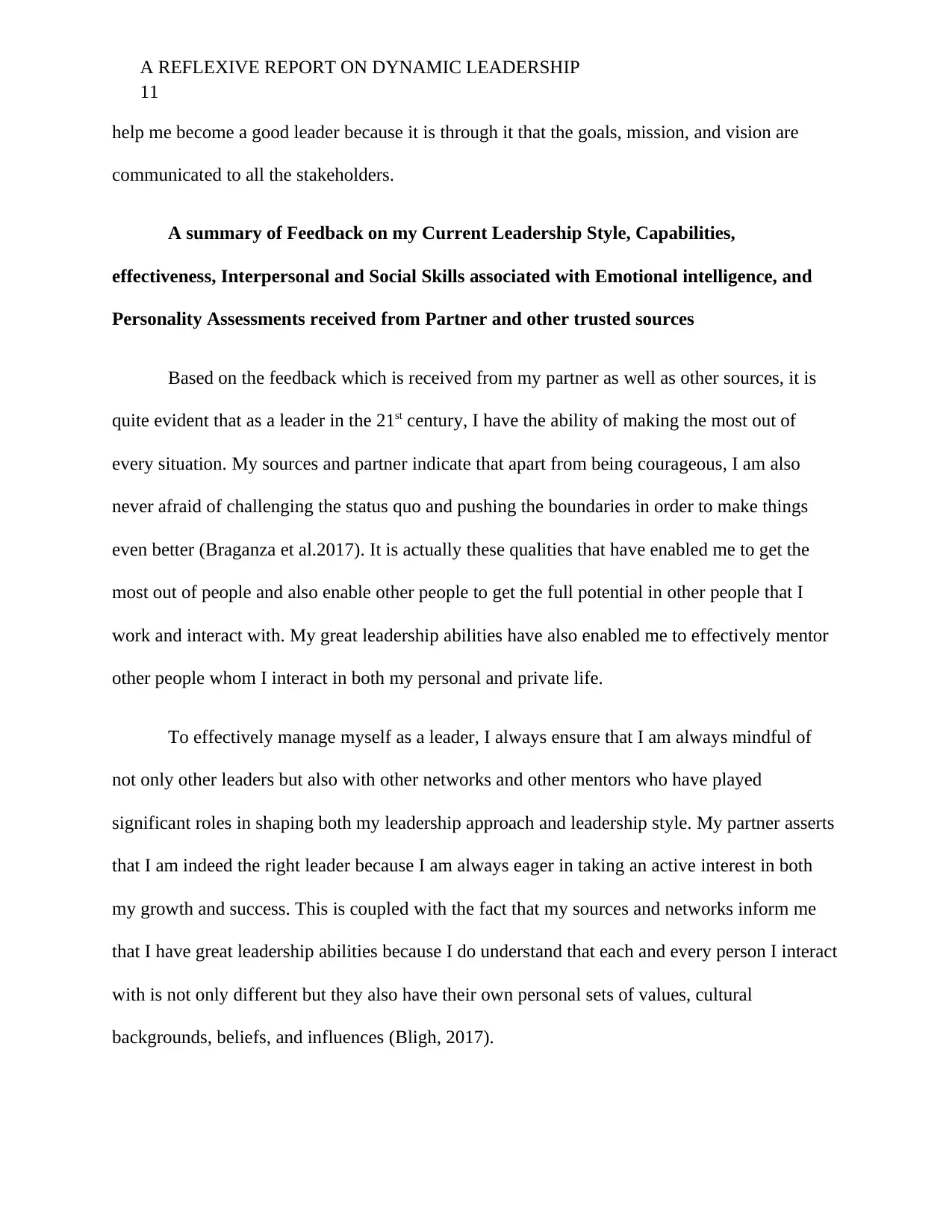
A REFLEXIVE REPORT ON DYNAMIC LEADERSHIP
11
help me become a good leader because it is through it that the goals, mission, and vision are
communicated to all the stakeholders.
A summary of Feedback on my Current Leadership Style, Capabilities,
effectiveness, Interpersonal and Social Skills associated with Emotional intelligence, and
Personality Assessments received from Partner and other trusted sources
Based on the feedback which is received from my partner as well as other sources, it is
quite evident that as a leader in the 21st century, I have the ability of making the most out of
every situation. My sources and partner indicate that apart from being courageous, I am also
never afraid of challenging the status quo and pushing the boundaries in order to make things
even better (Braganza et al.2017). It is actually these qualities that have enabled me to get the
most out of people and also enable other people to get the full potential in other people that I
work and interact with. My great leadership abilities have also enabled me to effectively mentor
other people whom I interact in both my personal and private life.
To effectively manage myself as a leader, I always ensure that I am always mindful of
not only other leaders but also with other networks and other mentors who have played
significant roles in shaping both my leadership approach and leadership style. My partner asserts
that I am indeed the right leader because I am always eager in taking an active interest in both
my growth and success. This is coupled with the fact that my sources and networks inform me
that I have great leadership abilities because I do understand that each and every person I interact
with is not only different but they also have their own personal sets of values, cultural
backgrounds, beliefs, and influences (Bligh, 2017).
11
help me become a good leader because it is through it that the goals, mission, and vision are
communicated to all the stakeholders.
A summary of Feedback on my Current Leadership Style, Capabilities,
effectiveness, Interpersonal and Social Skills associated with Emotional intelligence, and
Personality Assessments received from Partner and other trusted sources
Based on the feedback which is received from my partner as well as other sources, it is
quite evident that as a leader in the 21st century, I have the ability of making the most out of
every situation. My sources and partner indicate that apart from being courageous, I am also
never afraid of challenging the status quo and pushing the boundaries in order to make things
even better (Braganza et al.2017). It is actually these qualities that have enabled me to get the
most out of people and also enable other people to get the full potential in other people that I
work and interact with. My great leadership abilities have also enabled me to effectively mentor
other people whom I interact in both my personal and private life.
To effectively manage myself as a leader, I always ensure that I am always mindful of
not only other leaders but also with other networks and other mentors who have played
significant roles in shaping both my leadership approach and leadership style. My partner asserts
that I am indeed the right leader because I am always eager in taking an active interest in both
my growth and success. This is coupled with the fact that my sources and networks inform me
that I have great leadership abilities because I do understand that each and every person I interact
with is not only different but they also have their own personal sets of values, cultural
backgrounds, beliefs, and influences (Bligh, 2017).

A REFLEXIVE REPORT ON DYNAMIC LEADERSHIP
12
My life and leadership journey to my position I am in currently is founded on my ability
of both identifying and appreciating the differences which are brought on the table and knowing
how to effectively utilize them. My sources inform me that I am always emotionally intelligent
to an extent that I am always capable of connecting the opportunities and dots within every dot
thus enabled the potential of each person that I worked with to become realized. As a leader, I
have always never allowed any people I work with or interact with to “grow complacent”. To
ensure that this is achieved, I am therefore constantly testing and helping all people to effectively
develop their capabilities and skills in order for them to effectively prepare for the next phases of
their respective careers.
As a leader, I always encourage the people working under me to always act and think in
ways that naturally come to them. As a great leader, I don’t make my subjects to think the way
that I do but rather, I normally encourage them to embrace natural methods that can help them in
building my personal strengths (Schilke, Hu & Helfat, 2018). This has made my subjects to
know my default settings just through observing the major things which I “naturally gravitate”
towards as well as those ones which I don’t. As a leader, my partner and other sources inform me
that I always try my best in making sure that I put the people that I work with in situations that
will not only make them shine but which will also help them in leveraging their strengths. My
current leadership capabilities and potential are also highly founded on possession of good
judgment as well as ability of converting this into effective decision making processes in the
organization (Huffington, James & Armstrong, 2018).
Implications of feedback and my Reflection on its significance
12
My life and leadership journey to my position I am in currently is founded on my ability
of both identifying and appreciating the differences which are brought on the table and knowing
how to effectively utilize them. My sources inform me that I am always emotionally intelligent
to an extent that I am always capable of connecting the opportunities and dots within every dot
thus enabled the potential of each person that I worked with to become realized. As a leader, I
have always never allowed any people I work with or interact with to “grow complacent”. To
ensure that this is achieved, I am therefore constantly testing and helping all people to effectively
develop their capabilities and skills in order for them to effectively prepare for the next phases of
their respective careers.
As a leader, I always encourage the people working under me to always act and think in
ways that naturally come to them. As a great leader, I don’t make my subjects to think the way
that I do but rather, I normally encourage them to embrace natural methods that can help them in
building my personal strengths (Schilke, Hu & Helfat, 2018). This has made my subjects to
know my default settings just through observing the major things which I “naturally gravitate”
towards as well as those ones which I don’t. As a leader, my partner and other sources inform me
that I always try my best in making sure that I put the people that I work with in situations that
will not only make them shine but which will also help them in leveraging their strengths. My
current leadership capabilities and potential are also highly founded on possession of good
judgment as well as ability of converting this into effective decision making processes in the
organization (Huffington, James & Armstrong, 2018).
Implications of feedback and my Reflection on its significance
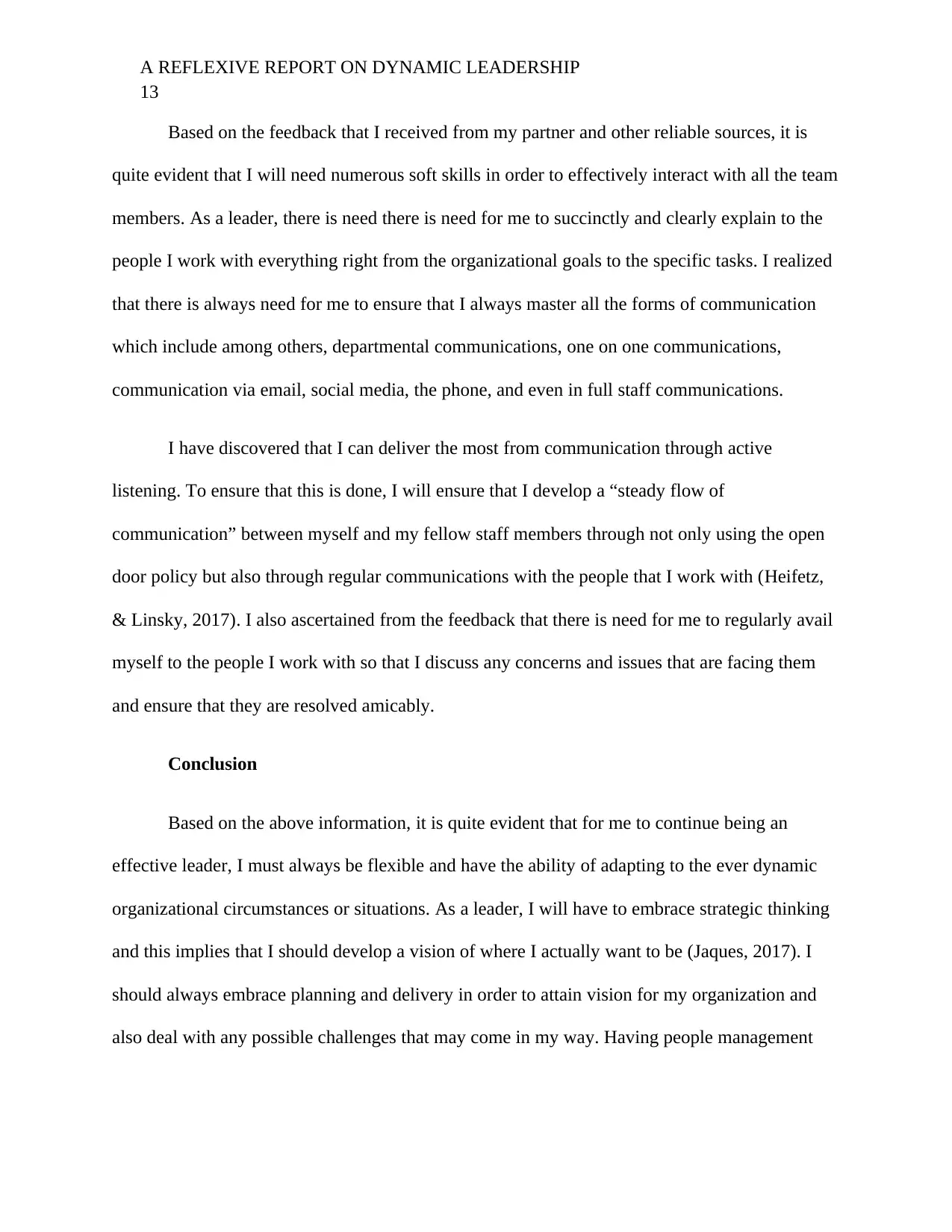
A REFLEXIVE REPORT ON DYNAMIC LEADERSHIP
13
Based on the feedback that I received from my partner and other reliable sources, it is
quite evident that I will need numerous soft skills in order to effectively interact with all the team
members. As a leader, there is need there is need for me to succinctly and clearly explain to the
people I work with everything right from the organizational goals to the specific tasks. I realized
that there is always need for me to ensure that I always master all the forms of communication
which include among others, departmental communications, one on one communications,
communication via email, social media, the phone, and even in full staff communications.
I have discovered that I can deliver the most from communication through active
listening. To ensure that this is done, I will ensure that I develop a “steady flow of
communication” between myself and my fellow staff members through not only using the open
door policy but also through regular communications with the people that I work with (Heifetz,
& Linsky, 2017). I also ascertained from the feedback that there is need for me to regularly avail
myself to the people I work with so that I discuss any concerns and issues that are facing them
and ensure that they are resolved amicably.
Conclusion
Based on the above information, it is quite evident that for me to continue being an
effective leader, I must always be flexible and have the ability of adapting to the ever dynamic
organizational circumstances or situations. As a leader, I will have to embrace strategic thinking
and this implies that I should develop a vision of where I actually want to be (Jaques, 2017). I
should always embrace planning and delivery in order to attain vision for my organization and
also deal with any possible challenges that may come in my way. Having people management
13
Based on the feedback that I received from my partner and other reliable sources, it is
quite evident that I will need numerous soft skills in order to effectively interact with all the team
members. As a leader, there is need there is need for me to succinctly and clearly explain to the
people I work with everything right from the organizational goals to the specific tasks. I realized
that there is always need for me to ensure that I always master all the forms of communication
which include among others, departmental communications, one on one communications,
communication via email, social media, the phone, and even in full staff communications.
I have discovered that I can deliver the most from communication through active
listening. To ensure that this is done, I will ensure that I develop a “steady flow of
communication” between myself and my fellow staff members through not only using the open
door policy but also through regular communications with the people that I work with (Heifetz,
& Linsky, 2017). I also ascertained from the feedback that there is need for me to regularly avail
myself to the people I work with so that I discuss any concerns and issues that are facing them
and ensure that they are resolved amicably.
Conclusion
Based on the above information, it is quite evident that for me to continue being an
effective leader, I must always be flexible and have the ability of adapting to the ever dynamic
organizational circumstances or situations. As a leader, I will have to embrace strategic thinking
and this implies that I should develop a vision of where I actually want to be (Jaques, 2017). I
should always embrace planning and delivery in order to attain vision for my organization and
also deal with any possible challenges that may come in my way. Having people management
Paraphrase This Document
Need a fresh take? Get an instant paraphrase of this document with our AI Paraphraser
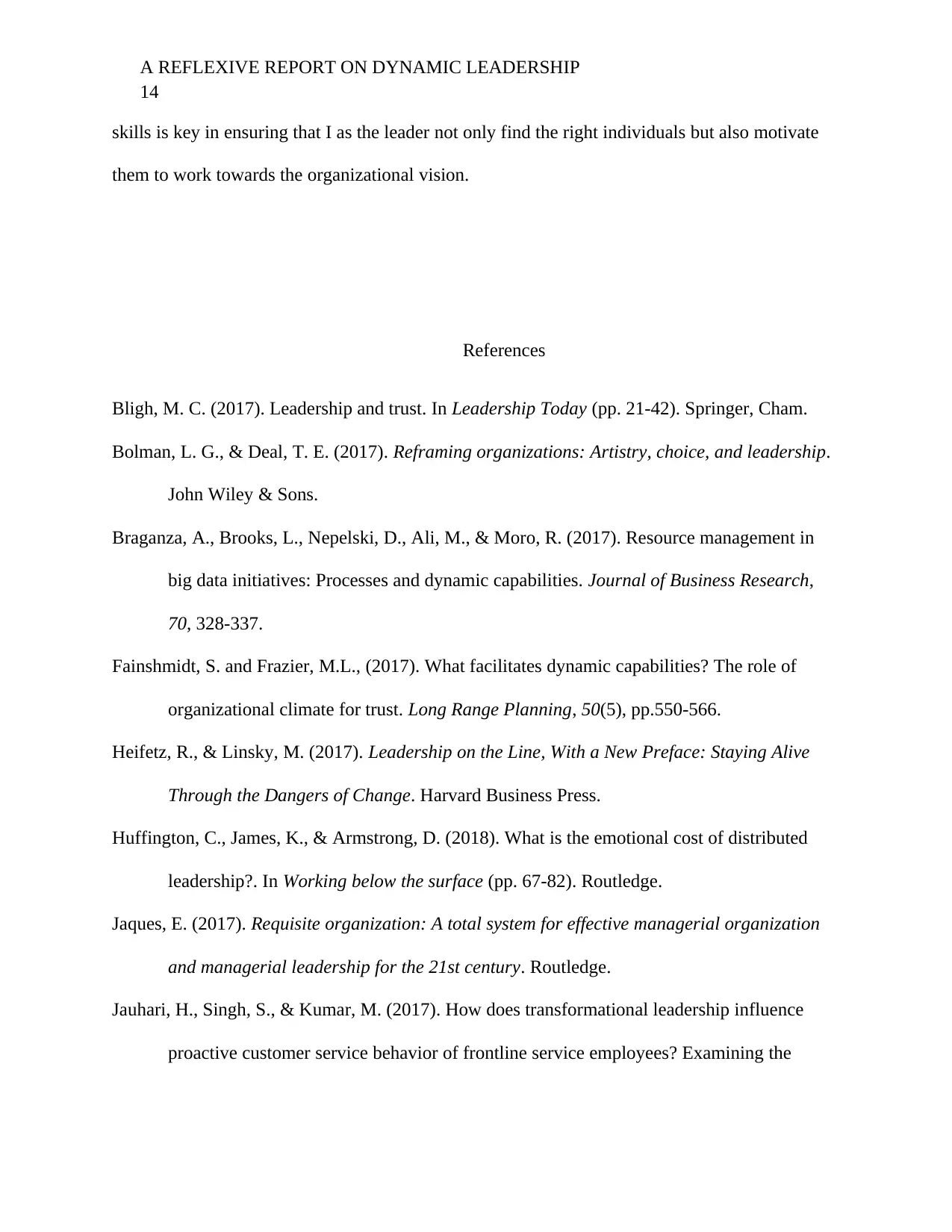
A REFLEXIVE REPORT ON DYNAMIC LEADERSHIP
14
skills is key in ensuring that I as the leader not only find the right individuals but also motivate
them to work towards the organizational vision.
References
Bligh, M. C. (2017). Leadership and trust. In Leadership Today (pp. 21-42). Springer, Cham.
Bolman, L. G., & Deal, T. E. (2017). Reframing organizations: Artistry, choice, and leadership.
John Wiley & Sons.
Braganza, A., Brooks, L., Nepelski, D., Ali, M., & Moro, R. (2017). Resource management in
big data initiatives: Processes and dynamic capabilities. Journal of Business Research,
70, 328-337.
Fainshmidt, S. and Frazier, M.L., (2017). What facilitates dynamic capabilities? The role of
organizational climate for trust. Long Range Planning, 50(5), pp.550-566.
Heifetz, R., & Linsky, M. (2017). Leadership on the Line, With a New Preface: Staying Alive
Through the Dangers of Change. Harvard Business Press.
Huffington, C., James, K., & Armstrong, D. (2018). What is the emotional cost of distributed
leadership?. In Working below the surface (pp. 67-82). Routledge.
Jaques, E. (2017). Requisite organization: A total system for effective managerial organization
and managerial leadership for the 21st century. Routledge.
Jauhari, H., Singh, S., & Kumar, M. (2017). How does transformational leadership influence
proactive customer service behavior of frontline service employees? Examining the
14
skills is key in ensuring that I as the leader not only find the right individuals but also motivate
them to work towards the organizational vision.
References
Bligh, M. C. (2017). Leadership and trust. In Leadership Today (pp. 21-42). Springer, Cham.
Bolman, L. G., & Deal, T. E. (2017). Reframing organizations: Artistry, choice, and leadership.
John Wiley & Sons.
Braganza, A., Brooks, L., Nepelski, D., Ali, M., & Moro, R. (2017). Resource management in
big data initiatives: Processes and dynamic capabilities. Journal of Business Research,
70, 328-337.
Fainshmidt, S. and Frazier, M.L., (2017). What facilitates dynamic capabilities? The role of
organizational climate for trust. Long Range Planning, 50(5), pp.550-566.
Heifetz, R., & Linsky, M. (2017). Leadership on the Line, With a New Preface: Staying Alive
Through the Dangers of Change. Harvard Business Press.
Huffington, C., James, K., & Armstrong, D. (2018). What is the emotional cost of distributed
leadership?. In Working below the surface (pp. 67-82). Routledge.
Jaques, E. (2017). Requisite organization: A total system for effective managerial organization
and managerial leadership for the 21st century. Routledge.
Jauhari, H., Singh, S., & Kumar, M. (2017). How does transformational leadership influence
proactive customer service behavior of frontline service employees? Examining the

A REFLEXIVE REPORT ON DYNAMIC LEADERSHIP
15
mediating roles of psychological empowerment and affective commitment. Journal of
Enterprise Information Management, 30(1), 30-48.
Laske, O., & De Visch, J. (2018). Dynamic Collaboration: Strengthening Self-Organization and
Collaborative Intelligence in Teams. Integral Leadership Review, 18(1).
Lopez-Cabrales, A., Bornay-Barrachina, M., & Diaz-Fernandez, M. (2017). Leadership and
dynamic capabilities: the role of HR systems. Personnel Review, 46(2), 255-276.
Pitelis, C. N., & Wagner, J. D. (2018). Strategic Shared Leadership and Organizational Dynamic
Capabilities. The Leadership Quarterly.
Rosenbach, W.E., (2018). Contemporary issues in leadership. Routledge.
Schilke, O., Hu, S., & Helfat, C. E. (2018). Quo vadis, dynamic capabilities? A content-analytic
review of the current state of knowledge and recommendations for future research.
Academy of Management Annals, 12(1), 390-439.
Shamir, B., & Howell, J. M. (2018). Organizational and contextual influences on the emergence
and effectiveness of charismatic leadership. In Leadership Now: Reflections on the
Legacy of Boas Shamir (pp. 255-281). Emerald Publishing Limited.
Tepper, B. J., Dimotakis, N., Lambert, L. S., Koopman, J., Matta, F. K., Man Park, H., & Goo,
W. (2018). Examining Follower Responses to Transformational Leadership from a
Dynamic, Person–Environment Fit Perspective. Academy of Management Journal, 61(4),
1343-1368.
Trong Tuan, L. (2017). Reform in public organizations: the roles of ambidextrous leadership and
moderating mechanisms. Public Management Review, 19(4), 518-541.
15
mediating roles of psychological empowerment and affective commitment. Journal of
Enterprise Information Management, 30(1), 30-48.
Laske, O., & De Visch, J. (2018). Dynamic Collaboration: Strengthening Self-Organization and
Collaborative Intelligence in Teams. Integral Leadership Review, 18(1).
Lopez-Cabrales, A., Bornay-Barrachina, M., & Diaz-Fernandez, M. (2017). Leadership and
dynamic capabilities: the role of HR systems. Personnel Review, 46(2), 255-276.
Pitelis, C. N., & Wagner, J. D. (2018). Strategic Shared Leadership and Organizational Dynamic
Capabilities. The Leadership Quarterly.
Rosenbach, W.E., (2018). Contemporary issues in leadership. Routledge.
Schilke, O., Hu, S., & Helfat, C. E. (2018). Quo vadis, dynamic capabilities? A content-analytic
review of the current state of knowledge and recommendations for future research.
Academy of Management Annals, 12(1), 390-439.
Shamir, B., & Howell, J. M. (2018). Organizational and contextual influences on the emergence
and effectiveness of charismatic leadership. In Leadership Now: Reflections on the
Legacy of Boas Shamir (pp. 255-281). Emerald Publishing Limited.
Tepper, B. J., Dimotakis, N., Lambert, L. S., Koopman, J., Matta, F. K., Man Park, H., & Goo,
W. (2018). Examining Follower Responses to Transformational Leadership from a
Dynamic, Person–Environment Fit Perspective. Academy of Management Journal, 61(4),
1343-1368.
Trong Tuan, L. (2017). Reform in public organizations: the roles of ambidextrous leadership and
moderating mechanisms. Public Management Review, 19(4), 518-541.
1 out of 15
Related Documents
Your All-in-One AI-Powered Toolkit for Academic Success.
+13062052269
info@desklib.com
Available 24*7 on WhatsApp / Email
![[object Object]](/_next/static/media/star-bottom.7253800d.svg)
Unlock your academic potential
© 2024 | Zucol Services PVT LTD | All rights reserved.





